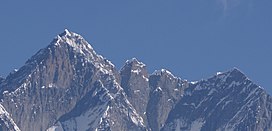| Lhotse Middle | |
|---|---|
| Lhotse Central I, Lhotse East[1] | |
 Lhotse Middle (centre left) and Lhotse Central II (centre right) situated between Lhotse (at far left) and Lhotse Shar (at far right) | |
| Highest point | |
| Elevation | 8,410[2] m (27,590 ft) |
| Prominence | 60[2] m (200 ft) |
| Parent peak | Lhotse |
| Isolation | 0.31 km (0.19 mi)[2] |
| Coordinates | 27°57′39.21″N 86°56′20.08″E / 27.9608917°N 86.9389111°E |
| Geography | |
| Parent range | Himalayas |
| Climbing | |
| First ascent | 23 May 23 2001 |
| Easiest route | Snow/rock climb |
Lhotse Middle (also called Lhotse Central I and Lhotse East), is a subsidiary peak of 8,410 metres (27,590 ft) in elevation that sits in the middle of a ridge between its parent peak, the eight-thousander, Lhotse 8,516 metres (27,940 ft), and another subsidiary peak, Lhotse Shar 8,383 metres (27,503 ft).[3][1] In 2013, a proposal by Nepal to the International Climbing and Mountaineering Federation (UIAA) to have Lhotse Middle (and Lhotse Shar) designated as standalone eight-thousanders was not successful due a perceived lack of topographic prominence.[4] Right beside the peak is the smaller subsidiary peak of Lhotse Central II (8,372 metres (27,467 ft); sometimes the term West tower and East tower are used to distinguish Lhotse Central I and Lhotse Central II, respectively (which can create confusion given Lhotse Middle's alternative name as Lhotse East, i.e being east of the parent Lhotse summit).[5]
- ^ a b Cite error: The named reference
russianclimbwas invoked but never defined (see the help page). - ^ a b c "Lhotse-Middle Summit". Peakbagger.com. Retrieved 12 December 2021.
- ^ Cite error: The named reference
AAJ_2002was invoked but never defined (see the help page). - ^ Khadka, Navin (18 October 2013). "Nepal mountain peak expansion bid stalls". BBC News. Retrieved 12 December 2021.
- ^ Eberhard Jurgalski [in German]. "Subsidiary Peaks". 8000ers.com. Retrieved 12 December 2021.

